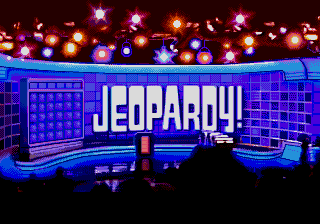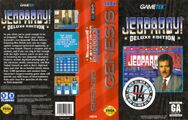Jeopardy! Deluxe Edition
From Sega Retro
| Jeopardy! Deluxe Edition | |||||||||||||||
|---|---|---|---|---|---|---|---|---|---|---|---|---|---|---|---|
| System(s): Sega Mega Drive | |||||||||||||||
| Publisher: GameTek | |||||||||||||||
| Developer: Park Place Productions | |||||||||||||||
| Licensor: Merv Griffin Enterprises | |||||||||||||||
| Sound driver: GEMS | |||||||||||||||
| Genre: Table | |||||||||||||||
| Number of players: 1-3 | |||||||||||||||
| |||||||||||||||
|
Jeopardy! Deluxe Edition is a 1993 game by Park Place Productions and GameTek. Unlike the other Jeopardy! games released by GameTek, this one only appeared on two platforms (the Sega Mega Drive and the Super NES).
Deluxe Edition is mostly identical to the earlier Jeopardy! game for the Mega Drive, but many of the categories and clues have been replaced and some of the art has been changed (including different sprites for the contestants).
Contents
Gameplay
The game is an adaptation of the long-running American quiz show Jeopardy! Compared to the preceding entry, many (but not all) of the categories and clues have been updated to new ones. The game claims to have have over 3,500 clues and 700 categories (the same as the previous edition). Each game consists of three rounds: Jeopardy!, Double Jeopardy!, and Final Jeopardy!
The game supports up to three contestants, and players can choose how many contestants are computer-controlled (which may be all of them if players want to watch the computer play a game). In two-player games, players can share the same control pad or use separate control pads. In three-player games, player one uses the first control pad and players two and three share the second control pad. Players can choose from five personas (three male and two female) with ![]() or
or ![]() at the start of the game. After entering a name, each player chooses a button to use for "buzzing in" (
at the start of the game. After entering a name, each player chooses a button to use for "buzzing in" (![]() ,
, ![]() , or
, or ![]() ), which must be a different button for players sharing the same control pad.
), which must be a different button for players sharing the same control pad.
Jeopardy! and Double Jeopardy!
The first two rounds feature a large game board consisting of six categories with five clues each (for a total of 30 clues per round) covering a variety of topics such as history, pop culture, or literature. The name of the category sometimes suggests the form that the response should take (such as "Men's Names" or "Ends In 'Y'"). Clues are valued by dollar amounts from lowest to highest, roughly increasing in difficulty. At the start of every round, players are given the opportunity to randomly select different categories after they are revealed by pressing ![]() when prompted.
when prompted.
The player in control of the board (initially the first player but subsequently whichever contestant last successfully answered a question) can choose any clue from any category. The D-Pad highlights a clue and ![]() selects it. The contestants are then presented with a trivia clue phrased as an answer. After a brief delay to give players time to read the clue, players are given 10 seconds to "buzz in." Any contestant can buzz in, regardless of which player chose the clue.
selects it. The contestants are then presented with a trivia clue phrased as an answer. After a brief delay to give players time to read the clue, players are given 10 seconds to "buzz in." Any contestant can buzz in, regardless of which player chose the clue.
When a contestant buzzes in, that player is given 60 seconds to respond to the clue by typing an answer (which the game will phrase in the form of a question). The D-Pad highlights a character, ![]() selects it,
selects it, ![]() deletes the last character, and
deletes the last character, and ![]() submits the answer. The game has some tolerance for misspellings and multiple names for things (for example, it will accept both "New York Times" and "NY Times" or "The Tempest" or "Tempest," and numbers can be spelled out or typed directly), and spaces are optional. Answering correctly awards the player the value of the clue and allows the player to select the next clue. Answering incorrectly (or not answering at all within the time limit) costs the player the value of the clue (potentially giving the player a negative score) and gives the other players an opportunity to buzz in. A contestant cannot buzz in on a question again after giving a wrong response. Computer players have a chance of buzzing in for each question. When they do buzz in, they may answer correctly or may give a nonsense wrong response. If nobody answers correctly, the host shows the correct response.
submits the answer. The game has some tolerance for misspellings and multiple names for things (for example, it will accept both "New York Times" and "NY Times" or "The Tempest" or "Tempest," and numbers can be spelled out or typed directly), and spaces are optional. Answering correctly awards the player the value of the clue and allows the player to select the next clue. Answering incorrectly (or not answering at all within the time limit) costs the player the value of the clue (potentially giving the player a negative score) and gives the other players an opportunity to buzz in. A contestant cannot buzz in on a question again after giving a wrong response. Computer players have a chance of buzzing in for each question. When they do buzz in, they may answer correctly or may give a nonsense wrong response. If nobody answers correctly, the host shows the correct response.
The Double Jeopardy! round plays the same as the first round, but the categories are different and the values of the clues are doubled.
The first two rounds end when every clue has been chosen.
Daily Double
A "Daily Double" clue is hidden behind one clue in the Jeopardy! round and two clues in Double Jeopardy! Before the clue is revealed, the contestant who has selected the Daily Double must declare a wager, from a minimum of $5 to a maximum of their entire score or the highest clue value available in the round, whichever is greater. Only the contestant who chooses the Daily Double can answer the clue.
A correct response adds the value of the wager to the contestant's score while an incorrect response (or failure to respond) deducts the same value. Whether or not the contestant responds correctly, they choose the next clue.
Final Jeopardy!
The Final Jeopardy! round features a single clue, chosen at random. Only contestants with at least $1 in winnings continue to this round. Players are given the category of the clue in advance. Each player chooses a wager as low as nothing or as high as their total winnings. The contestants are then given the clue and must answer individually.
In the television program, each contestant's wager and response is hidden until they have all finished responding. The game suggests that the other players not watch the screen while another player is responding to preserve the same surprise. Computer players have their wagers and responses obscured.
After the Final Jeopardy! round concludes, the player with the most money won wins the game.
Magazine articles
- Main article: Jeopardy! Deluxe Edition/Magazine articles.
Production credits
- Exec. Producer: Richard Knox Sr
- Producer: Tenzing Kernan
- Asst. Producer: Frank Simon
- Producer for GameTek: Neil Plakcy
- Programming: Mike Waltman, Gary Lindquist
- Artists: Curt Toumanian, Alesia Smith, Dave Estus
- Music and Sound Effects: Michelle Simon
- Special Thanks: Rod Humble, Jim Masterson, Liz Curran, Steve Curran, John Tombley, Gordon Walton
- And: Michael Knox, Troy Lyndon
- Developed by: Park Place Productions
- Programmed by: Mike Waltman, Gary Lindquist
- Art by: Alesia Smith, Curt Toumanian
- Sounds and Music by: Michelle Simon
- Producer for Park Place Productions: E. Tenzing Kernan
- Assistant Producer: Frank Simon
- Produced for GameTek by: Neil Plakcy
- Manual Written by: Elizabeth Curran
- Manual Editing: Stacey Ruderman
- Packaging and Manual Design by: Steve Curran, John Tombley
- Production Manager: Sherry Kross
- Illustration by: Richard Romeo
Physical scans
| ExpandSega Retro Average |
|---|
| 46 | |
|---|---|
| Based on 5 reviews | |
Technical information
- Main article: Jeopardy! Deluxe Edition/Technical information.
References
- ↑ File:Jeopardy Deluxe Edition MD credits.pdf
- ↑ File:JeopardyDeluxe MD US Manual.pdf, page 10
- ↑ Sega Mega Drive Advanced Gaming, "July 1994" (UK; 1994-0x-xx), page 44
- ↑ MegaTech, "June 1994" (UK; 1994-05-19), page 1
- ↑ Sega Zone, "July 1994" (UK; 1994-06-xx), page 30
- ↑ Tricks 16 bit, "Tricks Sega Gold 800 igr" (RU; 1998-03-20), page 94
- ↑ VideoGames, "August 1994" (US; 1994-0x-xx), page 83
| CollapseJeopardy! Deluxe Edition | |
|---|---|
|
Main page | Comparisons | Magazine articles | Reception | Region coding | Technical information | |
| CollapseGames based on Merv Griffin game shows for Sega systems | |
|---|---|
| Wheel of Fortune (1992) | Jeopardy! (1993) | Wheel of Fortune 2 (unreleased) | Jeopardy! Deluxe Edition (1994) | Jeopardy! Sports Edition (1994) | |
| Wheel of Fortune (1992) | Jeopardy! (1993) | Jeopardy! Sports Edition (1994) | |
| Wheel of Fortune (1994) | Jeopardy! (1994) | |


